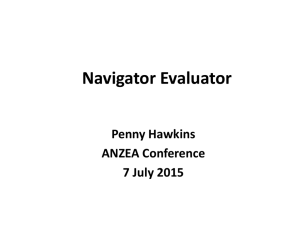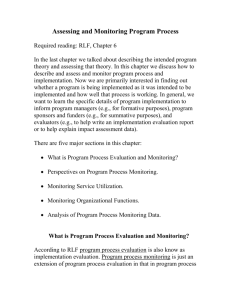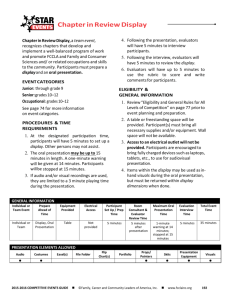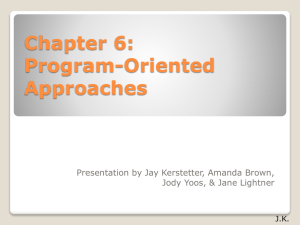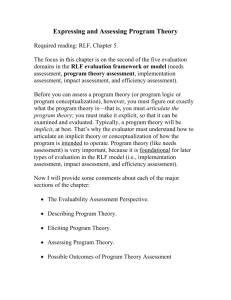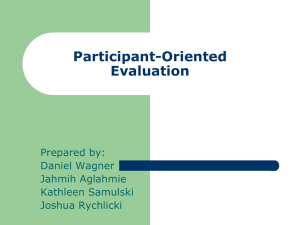Assessing the Need for a Program
advertisement
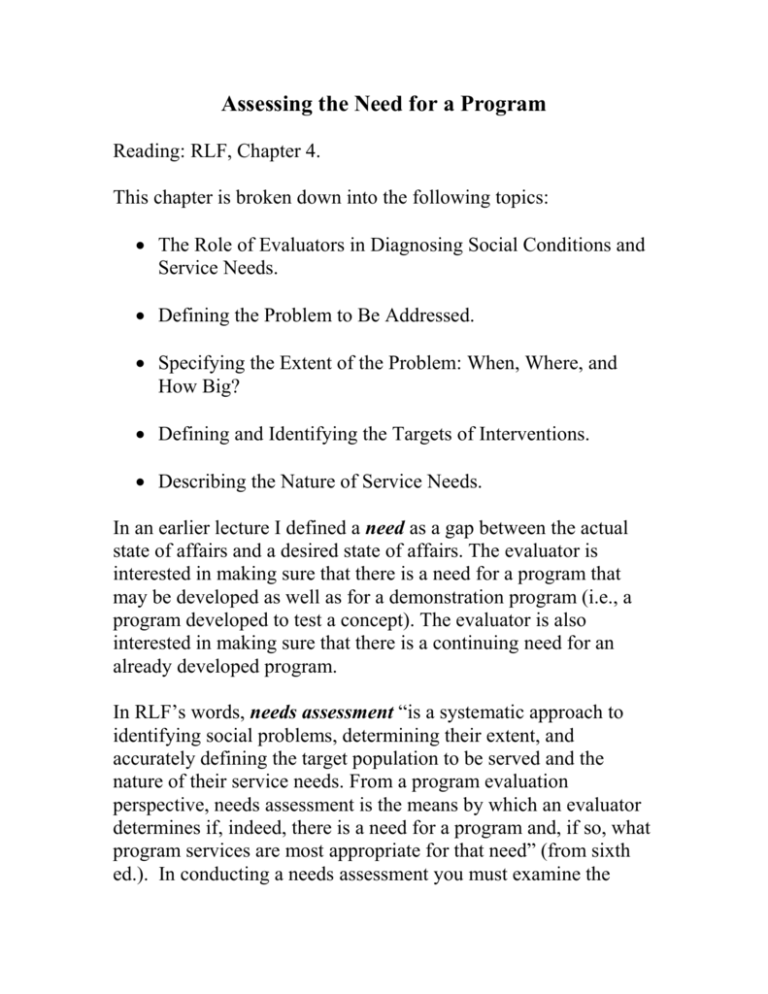
Assessing the Need for a Program Reading: RLF, Chapter 4. This chapter is broken down into the following topics: The Role of Evaluators in Diagnosing Social Conditions and Service Needs. Defining the Problem to Be Addressed. Specifying the Extent of the Problem: When, Where, and How Big? Defining and Identifying the Targets of Interventions. Describing the Nature of Service Needs. In an earlier lecture I defined a need as a gap between the actual state of affairs and a desired state of affairs. The evaluator is interested in making sure that there is a need for a program that may be developed as well as for a demonstration program (i.e., a program developed to test a concept). The evaluator is also interested in making sure that there is a continuing need for an already developed program. In RLF’s words, needs assessment “is a systematic approach to identifying social problems, determining their extent, and accurately defining the target population to be served and the nature of their service needs. From a program evaluation perspective, needs assessment is the means by which an evaluator determines if, indeed, there is a need for a program and, if so, what program services are most appropriate for that need” (from sixth ed.). In conducting a needs assessment you must examine the social conditions and the specific problem that a program is intended to address. Needs assessment is foundational for program evaluation because without a social or training need (or some other kind of need), there obviously is no need for a program! I like RLF’s point that a “needs” and “problems” are social constructions that are socially negotiated by a set of social agents. Deciding what is a need involves values and beliefs, and these interact is a political arena. What is not considered a need at one point in time may later come to be considered a real need, and vice versa. It is important to remember that at any point in time, different people and groups will often have different perspectives about any particular “need.” A key idea in needs assessment is that the evaluator should consider these different perspectives, especially the perspectives of different stakeholder groups, including the group that will receive the program services. I will now provide some summary comments on the major sections of this chapter. The Role of Evaluators in Diagnosing Social Conditions and Service Needs Evaluators are usually not the primary agent in identifying needs. Other agents usually have a larger role in defining needs, such as political bodies, interest groups, senior management, academics, investigative reporters, and religious leaders. In fact, the evaluator is often brought into a project after a need has already been established. Nonetheless, evaluators are also interested in needs because, as mentioned above, needs are foundational and the evaluator must be convinced that the program is needed. The evaluator needs to understand the program assumptions and the nature and scope of the problem it is intended to address. Precise information about the program targets and the intervention context are essential; otherwise, a well intentioned program will fail. Evaluators need to assess whether planned or actual program services match the local context and the specific needs of the target population. The steps in a needs assessment are as follows: 1. Identify the users and uses of the needs assessment. Identify key stakeholders and include them in your planning process so that their perspectives will be represented and so that they will buy into the needs assessment. Participation make utilization of results more likely. 2. Develop a needs assessment plan. Include the major needs assessment questions, a data collection plan, a data analysis plan, and a report and dissemination and utilization plan. 3. Collect and analyze the data. Use applied research techniques. Remember to use multiple sources of data, and to collect more data when needed. 4. Describe the target population and the service environment. Detailed and specific information is needed about the potential target population, including the definition of the target population, their characteristics, their location, their resources, their beliefs, and the current services that are already available to the target population. 5. Identify the needs. That is, identify the problem (i.e., Is there is a problem or need, in your evaluative judgment?). Identify some possible solutions to the problem or need. Don’t forget to include stakeholders’ perspectives. 6. Make the needs assessment. Now put the information together, usually in a formal report, and include your evaluative judgments and your action recommendations. Answer the questions, What is the problem or need? and What specific kind of program, if any, is needed to help solve the problem or need? 7. Communicate the results of your needs assessment. Disseminate results and follow actions in your utilization plan. Remember, you want your work to be used. Defining the Problem to Be Addressed As mentioned earlier, a social problem is, in many ways, a social construction. RLF point out that problems and programs “...typically arise out of some stakeholder dissatisfaction with the effectiveness of existing policies and programs or concern that a new social problem has emerged.” Hopefully, the determination of needs and problems can be brought about through systematic examination of data and evidence, and this is where formal needs assessment comes into play. Don’t forget that valuing is an important part of needs assessment, and evaluators should be helpful in conducting needs assessment because evaluation is about valuing. When evaluators are not involved in the formal needs assessment, they still must examine and evaluate policymakers’ and program managers’ definitions of the problem or needs. If the evaluator sees a problem with their definition, the evaluator must point this discrepancy out and offer or help negotiate an alternative. Specifying the Extent of the Problem: When, Where, and How Big? Program design should be based on a clear understanding of the size, distribution, and nature of the problem or need. How may people have the problem or condition? Where are they located? What are their characteristics? There are many ways to make these determinations, including the following systematic approaches: Use existing data sources (i.e., already collected data) to develop estimates of the problem characteristics. Some examples of existing data include U.S. Census data (which are available down to track and zip code levels), state records such as vital statistics, local government records, agency records, and social indicators (i.e., time-series measures of various outcomes such as poverty level over time, unemployment rates, crime victimization rates, drug use percentages, education trends, and employment trends). o Be sure to avoid the problems of undercounting (missing or excluding some individuals who are in need) and overcounting (including individuals who are not in need). You may have to obtain estimates of the problem characteristics through social research (i.e., you may need to collect new empirical research data). The most commonly used data collection method for this purpose is the needs assessment survey (in which data are collected using questionnaires and/or interviews). Other commonly used methods are focus groups (small group discussions with key stakeholders or informants) and key informant interviews (i.e., interviews with individuals with special inside knowledge about the problem or need and the target population). Whatever data collection method you select (and you will probably use a combination of methods), it is essential that the data be representative or, if not, that you understand the ways in which the data are not representative and you attempt to compensate those data with additional data. In some cases you may need to use forecasting techniques to estimate the degree of need that will be present in the near future, but remember that long term forecasting can be very unreliable. Defining and Identifying the Targets of Interventions and Describing Target Populations Target definition and identification is so important that RLF include a separate section. Typically, program targets are individuals (e.g., high school students who have been caught using drugs, new employees who need orientation training, managers who do not use computers); however, program targets may include other types of units, such as organizations, conditions, groups, or physical units. For example, schools with very low standardized test scores may be targeted for special services. Keep in mind that your ideal target population (the larger population to which you would like to target program services) may differ from the accessible population (the population to whom you can realistically expect to find, reach, and deliver services). The accessible population is the group that you can feasibly reach and serve. You should try to be as precise as you can when specifying your program targets, and try to use inclusion rules that minimize over-inclusion and under-inclusion. RLF explain several terms (taken mostly from the field of public health) that are useful in thinking about program targets and their characteristics. I will list the terms and provide definitions here: Prevalence – the number of existing cases experiencing the problem in a particular area at a specified time (e.g., the number of employees experiencing high levels of stress in a organization). Incidence – the number of new cases of a problem that arise in a specific area during a specific period of time (e.g., the number of employees in an organization who reach the high stress threshold this year). Population at risk – a group that has a significant probability of developing a specific problem or condition. Sensitivity versus specificity – the former is extent to which the criteria used to identify cases provides true positives (i.e., people who really do have the condition are identified); the latter is the extent to which the criteria used to identify cases avoids false positives (i.e., people who do not have the condition are excluded). Population in need versus demand – the former refers to the individuals who currently manifest the condition and are, therefore, in need of the program service. In contrast, demand refers to the condition where an individual desires the program services and is willing to participate. Some individuals who are in-need may not want or demand the program services. Rates – a rate is a number that expresses the proportion of units that has a specific condition (e.g., people in poverty, people who use crack cocaine, people who have never been trained in use of a particular software program). Rates are often given as incidence percentages (e.g., 30% of the employees in Company XYZ have not been trained) or as incidence per 100 or per 1,000 (e.g., in 1997 the victimization rate of females for rape or other sexual assault was 0.4 per 1,000). o Rates are useful in describing the characteristics of groups and subgroups (e.g., 30% of the employees in Company XYZ have not been trained to use a new software program). o Rates are also extremely useful in comparing the conditional probabilities that different groups have a characteristic (e.g., 65% of managers have been trained in stress management versus 5% of line workers have been trained in stress management). Describing the Nature of Service Needs It is important to have detailed information about the local nature of the problem a program is supposed to address. For example, a generic stress management program will not work equally well with all populations or subgroups. You must understand the unique characteristics of the people who are the clients of the program. You should attempt to understand the following: The cultural characteristics of the program population. The resources of the program population. Difficulties or barriers potential participants may face, making it difficult for them to participate in the program. Perceptions of participants about how they view and experience the problem: Do they agree that they need the training you believe they need? Have they heard about the program? Do they expect the program to be worthwhile given their perceived needs? What are the causes of the problem condition? What are some relevant, and perhaps unique, characteristics of the targeted program participants? The bottom line is that you want to understand the targeted participants in their context. If you do not understand potential participants then the proposed program is likely to fail. For example, too often policymakers, with little or no understanding of their target population, develop laws and programs that they believe will change the behavior of the people in their target population. I call this armchair policy making. An example would be making “rational middle class” policy that is supposed to decrease the street use of drugs and/or property crime. Another example occurred in the early 1960s (according to a demography professor of mine many years ago) when the United States government sent boxes of “the pill” (i.e., the contraceptive taken in pill form to prevent pregnancy). The problem was that the at risk Indian women were not used to taking pills orally, and, therefore, they did use the pills. Taking pills was not part of their culture. How are we to better understand a target population? One useful way is to use a two stage strategy. First, use qualitative methods (e.g., focus groups, in-depth interviews, observations) to explore and delve into the nature of the problem and study how and why it seems to operate. Second, follow-up the qualitative phase with the use of quantitative methods (e.g., questionnaires, structured interviews, tests) to better document the extent and distribution of the problem and to test hypotheses generated in the qualitative stage. Once you obtain this kind of information, you will be able to tailor a program to the particular needs of your targeted participants in their particular context. In sum, it takes a lot of systematic effort to design, develop, and maintain successful programs.
